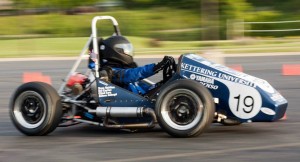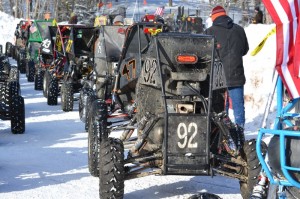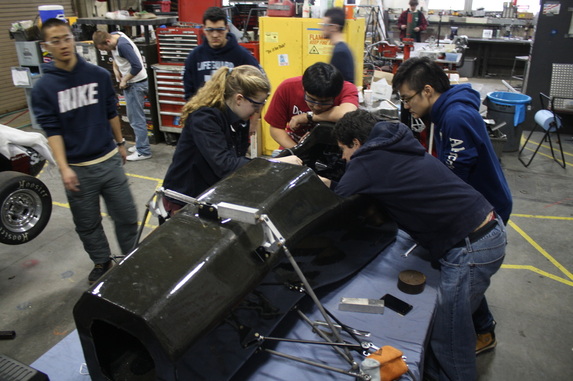The auto industry can be highly competitive—even cut-throat.
It’s that competition that has driven auto manufacturers to develop new innovations, create new vehicle concepts, and even launch all-out war on one another. From the introduction of the V8 engine to muscle car wars of the 1960s, competition has fueled the industry.
In an effort to prepare the next generation of automotive professionals to compete, innovate, and ultimately lead, colleges and universities offer their mechanical engineering students the opportunity to battle other schools in special engineering competitions: Formula SAE and Baja SAE.
Formula SAE
 Founded in 1979, Formula SAE is a student design competition in which students design, develop, and race a small Formula-style race car. Using a four-stroke, piston-powered engine no larger than 610cc, teams of students from over 400 different schools compete against one another in competitions around the world.
Founded in 1979, Formula SAE is a student design competition in which students design, develop, and race a small Formula-style race car. Using a four-stroke, piston-powered engine no larger than 610cc, teams of students from over 400 different schools compete against one another in competitions around the world.
During the competitions, the teams must participate in a series of static and dynamic events, including engineering design, cost analysis, and business presentation. To excel in these three static categories, they must explain and defend their design process and pitch their vehicle to a manufacturer that targets amateur weekend autocross drivers.
The dynamic portion of the competition includes vehicle performance tests for fuel efficiency and acceleration. Team also put their Formula-style vehicle to the test on an autocross course, skid-pad, and endurance competition. Teams can also earn points for special design innovations.
Baja SAE
 Like the Formula SAE competition, Baja SAE pits teams of automotive engineering students against each other in a series of competitions. However, Baja SAE is focused on driveline, suspension, and chassis design.
Like the Formula SAE competition, Baja SAE pits teams of automotive engineering students against each other in a series of competitions. However, Baja SAE is focused on driveline, suspension, and chassis design.
Each vehicle is built around the concept of a four-wheel, single seat off-road recreational vehicle intended for the weekend off-road enthusiast. Each team must use a stock ten-horsepower Briggs & Stratton engine as their starting point and must make the vehicle as safe, comfortable, and off-road friendly as possible.
During the actual Baja SAE competitions, the teams and vehicles are judged on suspension design, cost effectiveness, and business presentation. The dynamic competition includes acceleration, land maneuverability, water maneuverability, log pull, and endurance.
What do students learn from the competition? What innovations have they developed? And how will these students use the experience as future leaders in the auto industry?
All week long, we’ll highlight some top collegiate automotive engineering programs in our Campus Pit Stop series and show you how the hands-on work they’re doing now could impact the future of the auto industry.


[…] « Campus Pit Stop: How 6 Universities are Shaping the Future Auto Industry Today […]
[…] Editor’s Note: This is Part 2 of our Campus Pit Stop series of articles highlighting automotive engineering work being done on campuses across America. The series covers some of the the schools’ participation in the Formula SAE and Baja SAE programs. For more information on these programs, please see our Campus Pit Stop introduction post. […]
[…] Editor’s Note: This is Part 3 of our Campus Pit Stop series of articles highlighting automotive engineering work being done on campuses across America. The series covers some of the the schools’ participation in the Formula SAE and Baja SAE programs. For more information on these programs, please see our Campus Pit Stop introduction post. […]
[…] Editor’s Note: This is Part 4 of our Campus Pit Stop series of articles highlighting automotive engineering work being done on campuses across America. The series covers some of the the schools’ participation in the Formula SAE and Baja SAE programs. For more information on these programs, please see our Campus Pit Stop introduction post. […]
[…] Editor’s Note: This is Part 5 of our Campus Pit Stop series of articles highlighting automotive engineering work being done on campuses across America. The series covers some of the the schools’ participation in the Formula SAE and Baja SAE programs. For more information on these programs, please see our Campus Pit Stop introduction post. […]
[…] Editor’s Note: This is Part 6 of our Campus Pit Stop series of articles highlighting automotive engineering work being done on campuses across America. The series covers some of the the schools’ participation in the Formula SAE and Baja SAE programs. For more information on these programs, please see our Campus Pit Stop introduction post. […]
[…] Editor’s Note: This is Part 7 of our Campus Pit Stop series of articles highlighting automotive engineering work being done on campuses across America. The series covers some of the schools’ participation in the Formula SAE and Baja SAE programs. For more information on these programs, please see our Campus Pit Stop introduction post. […]
Nowadays, students have access to a huge amount of information, and this, of course, influences the emergence of modern specialists, who may well change our vision of already existing things we are used to. These young specialists need some help from friends, family, and other students. For example, if they need help with writing essays, they can read the best review at essayreviewexpert.com, where they find top-5 writing service in 2019 and many other reviews.
https://www.onallcylinders.com/2013/10/20/campus-tour-6-universities-shaping-future-auto-industry-today/#comment-59421 great article!
Really cool article!